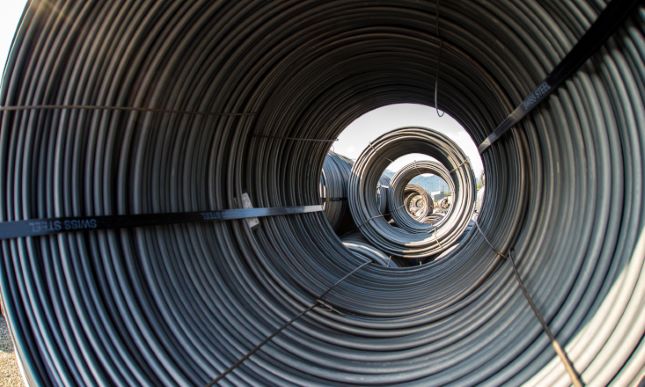Swiss Steel: Improved resilience through cost flexibility and transformation
by Hans Diederichs

The financial figures of Swiss Steel in the third quarter of 2020 were affected by seasonally lower demand in the summer months and the impact of the COVID-19 crisis. Even though the demand situation seemed to have started recovering towards the end of the third quarter, sales volumes, revenue, and adjusted EBITDA remain low. Changes to the cost structure meant that adjusted EBITDA, at EUR –21.1 million, was less negative year-on-year despite the decrease in revenue. By managing our net working capital consistently and curbing investment, we were able to achieve a positive free cash flow of EUR 9.3 million.
Business performance in the third quarter of 2020
At 332 kilotons, 18.0 % less steel was sold in the third quarter of 2020 than in the prior-year quarter (Q3 2019: 405 kilotons). This fall is evidenced in all product categories, though the decline in sales volume for quality & engineering steel was greatest at 19.8 %. As the recovery in demand from the automotive industry is taking a while to impact the sales volume, less quality & engineering steel was sold at the start of the third quarter of 2020 in particular than in the same quarter of last year. In addition, the fall in demand in mechanical and plant engineering, which is another key end customer market for quality & engineering steel, continued in the third quarter of 2020.
Sales volumes also decreased compared with the prior-year quarter in the two product groups of stainless steel and tool steel, but with less severe declines of 13.9 % and 12.5 % respectively. The oil price shock in the second quarter of 2020 led to a global downturn in the oil and gas industry. These impacts could clearly be felt in the third quarter of 2020 and were reflected particularly in a reduced sales volume for the tool steel product group.
The average sales price per ton of steel was EUR 1,534.30 in the third quarter of 2020, which is 7.3 % lower than in the prior-year quarter (Q3 2019: EUR 1,654.60 per ton). This was despite the slightly positive movement in prices for scrap and alloy surcharges following the COVID-19-related slump. The decline is due to the ongoing high price pressure, which has particularly affected the stainless steel product group.
The negative development in prices and the contraction in sales volume led to revenue of EUR 509.4 million, down 24.0 % on the prior-year quarter. This decline was at its most pronounced in the quality & engineering steel product group, which posted a fall of 27.5 %. Revenue from stainless steel was down by 21.3 %, and from tool steel by 19.9 %.
Nearly all regions of the world posted a double-digit decline in revenue compared with the prior-year quarter. Only in China was positive growth recorded of 10.6 % year-on-year. The recovery of the Chinese automotive industry, as forecast in March 2020, was consequently realized in improved revenues in the third quarter of 2020.
Changes to the cost structure to accommodate the fall in demand and further progress in the transformation program meant that EBITDA adjusted for one-time effects, at EUR –21.1 million, was less negative than in the prior-year quarter despite the decline in revenue (Q3 2019: EUR –32.9 million). One-time effects amounted to EUR 7.7 million and are attributable to consultancy services in connection with efficiency improvement programs, restructuring measures, and the procurement of COVID-19 protective materials. Including these one-time effects, EBITDA rose to EUR –28.8 million (Q3 2019: EUR –64.2 million).
As a result, the adjusted EBITDA margin rose to –4.1 % (Q3 2019: –4.9 %), and the EBITDA margin to –5.7 % (Q3 2019: –9.6 %). In the seasonally weak third quarter of 2020, which was also impacted by the consequences of the COVID-19 crisis, the Group posted a negative result of EUR –66.3 million. In the third quarter of 2019 this was significantly higher at EUR –432.2 million which was predominantly driven by the impairments amounting to EUR -297.4 million.
Net debt, comprising current and non-current financial liabilities less cash and cash equivalents, came to EUR 610.4 million, which was down on the figure as at December 31, 2019 of EUR 797.6 million. This was due to the capital increase in the first quarter of 2020. Despite ongoing negative operating results, net debt was strictly limited thanks to consistent liquidity management with a focus on working capital and investments since early 2020.
Outlook for fiscal year 2020
The focus for the fourth quarter of 2020 will continue to be on optimizing liquidity and implementing the transformation program. We will support demand normalization with human and financial resources as needed. We will continue to ensure that our production and, with this, our cost structure are as flexible as possible.
We expect that automotive will continue to recover in the fourth quarter of 2020, narrowing the gap to the prior-year level, while recovery will be sluggish in the mechanical and plant engineering as well as energy sectors.
Source and graphic: Swiss Steel Group

